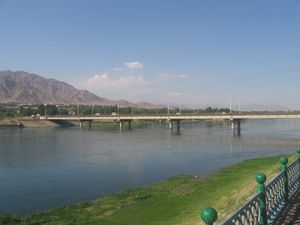سيحون
| Syr Darya (بالقزخية: Сырдария اوزبكية: Sirdaryo بالطاجيكية: Сирдарё) | |
| Jaxartes, Seyhun | |
| River | |
| Name origin: unknown | |
| البلدان | |
|---|---|
| الروافد | |
| - يسار | Kara |
| - يمين | نارين, Chirciq, Arys, Chu, Sarysu |
| المدن | خوجند، طاجيكستان, طشقند، اوزبكستان, تركستان، قزخستان, Kyzylorda, KZ, بايكونور |
| Source | Confluence of Naryn and Kara Darya |
| - الموقع | وادي فرغانة, اوزبكستان |
| - elevation | 400 m (1,312 ft) |
| - coordinates | 40°54′03″N 71°45′27″E / 40.90083°N 71.75750°E |
| المصب | بحر آرال |
| - الموقع | كزالي, قزخستان |
| - الارتفاع | 42 m (138 ft) |
| - الاحداثيات | 46°09′15″N 60°52′25″E / 46.15417°N 60.87361°E |
| الطول | 2,212 km (1,374 mi) |
| الحوض | 402,760 km2 (155,507 sq mi) |
| التدفق | |
| - المتوسط | 1,180 m3/s (41,671 cu ft/s) [1] |
خريطة لمفيض نهر سيحون. حدود بحر آرال هي من عام 1960.
| |
نهر سيحون ( /ˌsɪər ˈdɑr.jə/, Persian pronunciation: [siːɾ dæɾˈjɒː]),[أ] historically known as the Jaxartes ( /dʒækˈsɑrtiːz/, باليونانية قديمة: Ἰαξάρτης) هو أحد أنهار وسط آسيا وأحد أكبر نهرين في اوزبكستان. The name, which is Persian, literally means Syr Sea or Syr River. It originates in the Tian Shan Mountains in Kyrgyzstan and eastern Uzbekistan and flows for 2,256.25 kilometres (1,401.97 mi) west and north-west through Uzbekistan and southern Kazakhstan to the northern remnants of the Aral Sea. It is the northern and eastern of the two main rivers in the endorheic basin of the Aral Sea, the other being the Amu Darya (Jayhun).
In the Soviet era, extensive irrigation projects were constructed around both rivers, diverting their water into farmland and causing, during the post-Soviet era, the virtual disappearance of the Aral Sea, once the world's fourth-largest lake. The point at which the river flows from Tajikistan into Uzbekistan is, at 300 m (980 ft) above sea level, the lowest elevation in Tajikistan.[2][3][4]
. . . . . . . . . . . . . . . . . . . . . . . . . . . . . . . . . . . . . . . . . . . . . . . . . . . . . . . . . . . . . . . . . . . . . . . . . . . . . . . . . . . . . . . . . . . . . . . . . . . . . . . . . . . . . . . . . . . . . . . . . . . . . . . . . . . . . . . . . . . . . . . . . . . . . . . . . . . . . . . . . . . . . . . .
التاريخ
When the Macedonian army of Alexander the Great reached the Jaxartes in 329 BCE, after travelling through Bactria and Sogdia without encountering any opposition, they met with the first instances of native resistance to their presence. In October 329 BC the Macedonians fought the Battle of Jaxartes against the Saka, killing some 1200 combatants including the leader of the nomads. Alexander was forced to retire south to deal with a revolt in Sogdia. Alexander was wounded in the fighting that ensued and the native tribes took to attacking the Macedonian garrisons stationed in their towns. As the revolt against Alexander intensified it spread through Sogdia, plunging it into two years of warfare, the intensity of which surpassed any other conflict of the Anabasis Alexandri.[5]
On the shores of the Syr Darya Alexander placed a garrison in the City of Cyrus (Cyropolis in Greek), which he then renamed after himself Alexandria Eschate—"the farthest Alexandria"—in 329 BCE. For most of its history since at least the Muslim conquest of Central Asia in the 7th to 8th centuries CE, the name of this city (in present-day Tajikistan) has been Khujand.
In the mid-19th century, during the Russian conquest of Turkestan, the Russian Empire introduced steam navigation to the Syr Darya, initially from Fort Raim[6] but with an important river port at Kazalinsk (Kazaly) from 1847 to 1882, when service ceased.
During the Soviet era, a resource-sharing system was instituted in which Kyrgyzstan and Tajikistan shared water originating from the Amu Darya and Syr Darya rivers with Kazakhstan, Turkmenistan, and Uzbekistan in summer. In return, Kyrgyzstan and Tajikistan received Kazakh, Turkmen, and Uzbek coal, gas, and electricity in winter. After the 1991 fall of the Soviet Union this system disintegrated and the Central Asian nations have failed to reinstate it. Inadequate infrastructure, poor water-management, and outdated irrigation methods all exacerbate the issue.[7]
Geography
The river rises in two headstreams in the Tian Shan Mountains in Kyrgyzstan and eastern Uzbekistan—the Naryn River and the Kara Darya which come together in the Uzbek part of the Fergana Valley—and flows for some 2,212 kilometres (1,374 mi) west and north-west through Uzbekistan and southern Kazakhstan to the remains of the Aral Sea. The Syr Darya drains an area of over 800,000 square kilometres (310,000 sq mi), but no more than 200,000 square kilometres (77,000 sq mi) actually contribute significant flow to the river: indeed, two of the largest rivers in its basin, the Talas and the Chu, dry up before reaching it. Its annual flow is a very modest[1] 37 cubic kilometres (30,000,000 acre⋅ft) per year—half that of its sister river, the Amu Darya.
Along its course, the Syr Darya irrigates the most productive cotton-growing region in the whole of Central Asia, together with the towns of Kokand, Khujand, Kyzylorda and Turkestan.
Various local governments throughout history have built and maintained an extensive system of canals.[8] These canals are of central importance in this arid region. Many fell into disuse in the 17th and early 18th century, but the Khanate of Kokand rebuilt many in the 19th century, primarily along the Upper and Middle Syr Darya.
Name
The second part of the name (darya, دریا) means "lake" or "sea" in Persian and "river" in the Central-Asian Persian. The current name dates only from the 18th century.
The earliest recorded name was Jaxartes or Iaxartes (Ἰαξάρτης) in Ancient Greek, consist of two morpheme Iaxa and artes, found in several sources, including those relating to Alexander the Great. The Greek name hearkens back to the Old Persian name Yakhsha Arta ("True Pearl"), perhaps a reference to the color of its glacially-fed water.[9] More evidence for the Persian etymology comes from the river's Turkic name up to the time of the Arab conquest, the Yinçü, or "Pearl river", from Middle Chinese 眞珠 *ʈˠiɪn-t͡ɕɨo.[8][10] Tang Chinese also recorded this name as Yaosha River 藥殺水 (MC: *jɨɐk-ʃˠɛt) and later Ye River 葉河 (MC: *jiɛp).
Following the Muslim conquest, the river appears in the sources uniformly as the Seyhun (سيحون), one of the four rivers flowing from the Paradise (Jannah, جَنّة in Arabic).[11]
The current local name of the river, Syr (Sïr), does not appear before the 16th century. In the 17th century, Abu al-Ghazi Bahadur Khan, historian and ruler of Khiva, called the Aral Sea the "Sea of Sïr," or Sïr Tengizi.
الضرر البيئي
Massive expansion of irrigation canals in Middle and Lower Syr Darya during the Soviet period to water cotton and rice fields caused ecological damage to the area. The amount of water taken from the river was such that in some periods of the year, no water at all reached the Aral Sea. The Amu Darya in Uzbekistan and Turkmenistan faced a similar situation.
The uranium concentration of the stream water is increased in Tajikistan with values of 43 μg/L and 12 μg/L; the WHO guideline value for drinking water of 30 μg/L is partly exceeded. The main input of uranium occurs upstream in Uzbekistan and Kyrgyzstan.[12]
انظر أيضاً
ملاحظات
- ^ Also transliterated Syrdarya or Sirdaryo; بالقزخية: Сырдария, Syrdarııa, سىردارٸيا; روسية: Сырдарья́, النطق Syrdarjja; النطق الروسي: [sɨrdɐˈrʲja]; فارسية: سيردريا; بالطاجيكية: Сирдарё; تركية: Seyhun, Siri Derya; العربية: سيحون; اوزبكية: Sirdaryo/Сирдарё.
الهامش
- ^ أ ب Daene C. McKinney. "Cooperative Management of Transboundary Water Resources in Central Asia" (PDF). Ce.utexas.edu. Retrieved 2014-02-07.
- ^ "Tajikistan". The World Factbook. Retrieved 30 January 2020.
lowest point: Syr Darya (Sirdaryo) 300 m
- ^ "Territorial and border issues". Ministry of Foreign Affairs of the Republic of Tajikistan. 1 March 2010. Retrieved 31 January 2020.
The lowest spot of the country is on the height of 300 meters and the highest spot is on the height of 7495 meters above sea level.
- ^ "General information about Tajikistan". Conference on Interaction and Confidence-Building Measures in Asia. Retrieved 31 January 2020.
Tajikistan is a typical mountainous country with absolute heights from 300 to 7495 m.
- ^ Holt, Frank Lee (1989). Alexander the Great and Bactria: The Formation of a Greek Frontier in Central Asia. Brill. p. 53. ISBN 9004086129. Retrieved 31 March 2019.
- ^ Gucheval-Claugny, M. (1877). "l'Asie Centrale Et Le Réveil De La Question D'Orient". Revue des Deux Mondes (1829-1971). 21 (2): 409. ISSN 0035-1962. JSTOR 44751873.
- ^ International Crisis Group. "Water Pressures in Central Asia", CrisisGroup.org. 11 September 2014. Retrieved 6 October 2014.
- ^ أ ب В. В. Бартольд. К истории орошения Туркестана. (On the history of Irrigation in Turkestan) in Работы по исторической географии (Works on Historical Geography). Moscow: Vostochnaia Literatura, 2002. Pages 210-231
- ^ "Sïr Daryā." Encyclopaedia of Islam, Second Edition. Edited by: P. Bearman, Th. Bianquis, C.E. Bosworth, E. van Donzel, W.P. Heinrichs. Brill Online, 2014.
- ^ Tekin, Talat (1997). "Notes on Some Chinese Loanwords in Old Turkic". Türk Dilleri Araştırmaları (7): 165–173.
- ^ The introductory chapters of Yāqūt's Muʿjam al-buldān, by Yāqūt ibn ʿAbd Allāh al-Ḥamawī, Page 30
- ^ P. Zoriy, M. Schläger, K. Murtazaev, J. Pillath, M. Zoriy, B. Heuel-Fabianek (2017): Monitoring of uranium concentrations in water samples collected near potentially hazardous objects in North-West Tajikistan.. Journal of Environmental Radioactivity, 181, pp. 109-117.
وصلات خارجية
| Syr Darya
]].- Articles containing قزخ-language text
- Articles containing روسية-language text
- Articles containing فارسية-language text
- Articles containing طاجيكية-language text
- Pages using Lang-xx templates
- Articles containing explicitly cited عربية-language text
- Articles containing أوزبكية-language text
- Pages using gadget WikiMiniAtlas
- صفحات المعرفة التي فيها البلد أو التقسيم غير معروف
- Pages using deprecated coordinates format
- Pages using geobox2 unit with unknown unit type
- Geobox usage tracking for river type
- Articles containing Ancient Greek (to 1453)-language text
- Articles containing الصينية الوسيطة المتأخرة-language text
- Articles with hatnote templates targeting a nonexistent page
- Coordinates on Wikidata
- أنهار طاجيكستان
- أنهار اوزبكستان
- أنهار قزخستان
- مواقع على طريق الحرير
- أنهار دولية في آسيا




